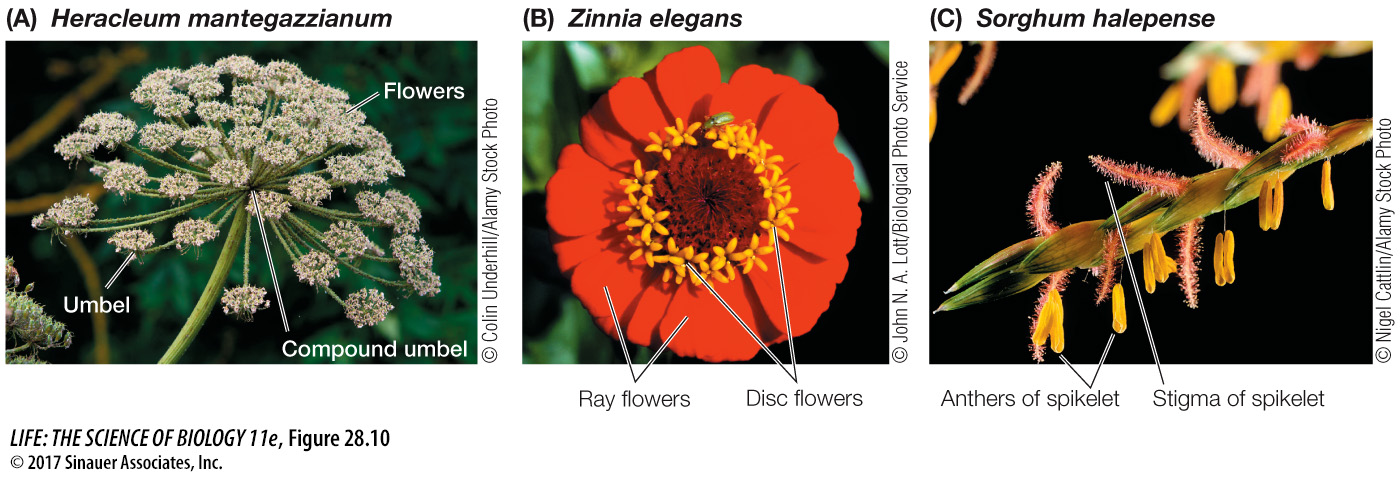The sexual structures of angiosperms are flowers
Flowers come in an astonishing variety of forms—just think of a few of the flowers you recognize. Flowers may be single, or they may be grouped together to form an inflorescence. Different families of flowering plants have characteristic types of inflorescences, such as the compound umbels of the carrot family (Figure 28.10A), the heads of the aster family (Figure 28.10B), and the spikes of many grasses (Figure 28.10C).

Figure 28.10 Inflorescences (A) The inflorescence of the giant hogweed, a member of the carrot family, is a compound umbel. Each umbel bears flowers on stalks that arise from a common center. (B) Zinnias are members of the aster family; their inflorescence is a head. Within the head, each of the long, petal-like structures is a ray flower; the central portion of the head consists of dozens to hundreds of disc flowers. (C) Some grasses, such as Johnson grass, have inflorescences called spikes, which are composed of many smaller groups of flowers, or spikelets.
If you examine any familiar flower, you will notice that the outer parts look somewhat like leaves. In fact, all the parts of a flower are modified leaves. The diagram in Figure 28.4B represents a generalized flower (for which there is no exact counterpart in nature). The structures bearing microsporangia are called stamens. Each stamen is composed of a filament bearing an anther that contains the pollen-producing microsporangia. The structures bearing megasporangia are called carpels. A structure composed of one carpel or two or more fused carpels is called a pistil. The swollen base of the pistil, is called the ovary, which contains one or more ovules. Each ovule contains a megasporangium surrounded by two protective integuments. The apical stalk of the pistil is the style, and the terminal surface that receives pollen grains is the stigma.
In addition, many flowers contain specialized sterile (non-spore-bearing) leaves. The inner ones are called petals (collectively, the corolla) and the outer ones sepals (collectively, the calyx). The corolla and calyx can be quite showy and often play roles in attracting animal pollinators to the flower. The calyx more commonly protects the immature flower in bud. From base to apex, these floral organs—sepals, petals, stamens, and carpels—are usually positioned in circular arrangements or whorls and attached to a central stalk.
The generalized flower in Figure 28.4B has both functional megasporangia and functional microsporangia; such flowers are referred to as perfect (or hermaphroditic). Many angiosperms produce two types of flowers, one with only megasporangia and the other with only microsporangia. Consequently, either the stamens or the carpels are nonfunctional or absent in a given flower, and the flower is referred to as imperfect.
Species such as corn or birch, in which both megasporangiate (female) and microsporangiate (male) flowers occur on the same plant, are said to be monoecious (“one-housed”—but, it must be added, one house with separate rooms). Complete separation of imperfect flowers occurs in some other angiosperm species, such as willows and date palms; in these species, an individual plant produces either flowers with stamens or flowers with carpels, but never both. Such species are said to be dioecious (“two-housed”).
